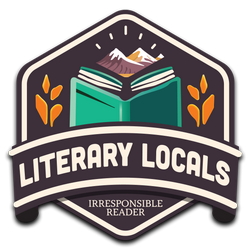 The Glass Frog
The Glass Frog
DETAILS: Publisher: Trailerback Books Publication Date: June 20, 2023 Format: Paperback Length: 376 pg. Read Date: July 27-30, 2024

Every Who is shaped by a Where.
In this case, the Where is a tiny coastal village named Seaside. from the beach there is a constant, breathy shhh-ahhh sound as the waves flow first in, then out, each exhalation coating the simple, whitewashed buildings with a fine, salty mist. Through the village center runs the Queen’s Road, a winding ribbon that traces the curving shoreline of the island nation to which Seaside belongs. Grassy, rolling hills surround the village to the north, so that when viewed from above, it appears as a single pearl on a string nestled on a bed of seagrass.
Seaside was given its unimaginative name by its unimaginative people. In fact, hostility toward creativity and change is a central feature of the Seasider mentality, a proud tradition handed down from generation to generation. They value simplicity, practicality, and—above all—uniformity. For this reason, it has been decreed that every building in the village must adhere to the same basic plan: squarish shape, white walls, dark roof. This arrangement makes it obvious which villagers are lax in their home maintenance, and are therefore not to be trusted. The same principle applies to matters of appearance, behavior, and topics of conversation. Unsurprisingly, the most popular topic of conversation is the failure of others to conform….
With the matter of Where set aside, it is time to meet our Who—Sophie Farrier, a kind-hearted and imaginative young girl who fits into Seaside about as well as a whale fits into a rowboat, and has been just as uncomfortably shaped.
What’s The Glass Frog About?
Thankfully for her, Sophie will not spend the entire novel in Seaside. But she has indeed been shaped by that village, and try as she might, she will act in the way she was shaped (both in ways she recognizes and ways she doesn’t). She’s also been shaped by books she’s read—a scandalous notion to many people in Seaside—and a devoted older brother, Damon, who has stepped up in so many ways that her deceased parents cannot and that her guardian aunt will not. Without her books and her brother, Seaside would’ve turned Sophie into a successfully conformed young woman.
Things change in Seaside one day when some kelp harvesters find an unconscious stranger who had the absolute temerity to wash up on shore. It’s rude, unheard of, and not at all fitting with the unimaginative ethos they prefer. There’s some debate amongst the villagers—with a majority wanting to send this stranger back to the sea he came from—but a couple of stalwarts (including Damon) refuse and arrange for him to be cared for by the local doctor. Sophie helps the doctor in her own way—and the doctor beings to think she might have a future in medicine.
When the stranger finally awakes, he wastes little time before he sets out to leave Seaside and resume his interrupted quest. Something about him, about what he says to her—and some drama at home—drives Sophie to follow him. Or try to, anyway. He has a pretty solid headstart and can move much more quickly than she can. Also…Sophie’s never left Seaside, so she really doesn’t know what to expect or how to interact with people who aren’t from there.
Meanwhile, a powerful group arrives at Seaside, demanding that the stranger be returned to them or the city will be destroyed. Everyone in the Village who was ready to throw him back into the sea are more than ready to give him up. If they only knew where he was.
So, what did I think about The Glass Frog?
I’m not certain who Lowry’s audience is, like the BlueInk Review cited on the back cover says, it can work for “discerning reader[s], from middle grade to adult.” I can think of readers I know/have known up and down that range who would appreciate the book, and I can’t think of any reasons to try to wave off a middle grader (which is refreshing).
It’s hard not to like Sophie—and I don’t understand why anyone would resist it—her brother is a little tougher to like, but that’s not necessarily his fault. Most people that she encounters after she leaves Seaside are pretty likable, too (with some notable, and easy-to-identify exceptions). The people of Seaside are an interesting mix—most (maybe all of them, I didn’t take a census) are good fictional characters and the reader will appreciate them as such. As people? Eh, it’s a mixed bag. But it’s a more complicated question than you’d expect from the early descriptions of the village.
I don’t believe Lowry’s prose was particularly purple at the beginning of the book, but it was headed to that end of the visible light spectrum. My notes said something like, “you’d better not use every adjective in your account too early or you won’t have any leftover for the last chapters.” I do think he got it under control pretty quickly—or I became inured to it, I’d believe either, but I think it’s the former.
There was some pretty solid comedy in this book (particularly involving the citizenry of Seaside), but it’s not a humorous fantasy in the mode of Terry Pratchett or Sean Gibson. I’d categorize it as a light, whimsical fantasy with some really funny moments. But there are some serious moments, too. A lot of heartbreak and loneliness—some self-destructive behaviors on display, too. Maybe a dash or two of romance. Plus some villainy, cowardice, avarice, xenophobia, and manipulation to balance out the acts of heroism (intentional or inadvertent). A little bit of everything, really.
I don’t know that I want a sequel to this—but I would like other books set in this work (with Sophie and those close to her showing up in the background). There’s just so much to explore, and Lowry has created a bunch of fun places and ideas to play with. Some of the minor characters from this book would be great to see again as protagonists—or at least, playing a larger role than they got to here.
But most of all, I’m curious about what the next novel (in this world or another) from Lowry will look like, I bet it’ll be worth the time—just like The Glass Frog was. You should check it out.

This post contains an affiliate link. If you purchase from it, I will get a small commission at no additional cost to you. As always, the opinions expressed are my own.






